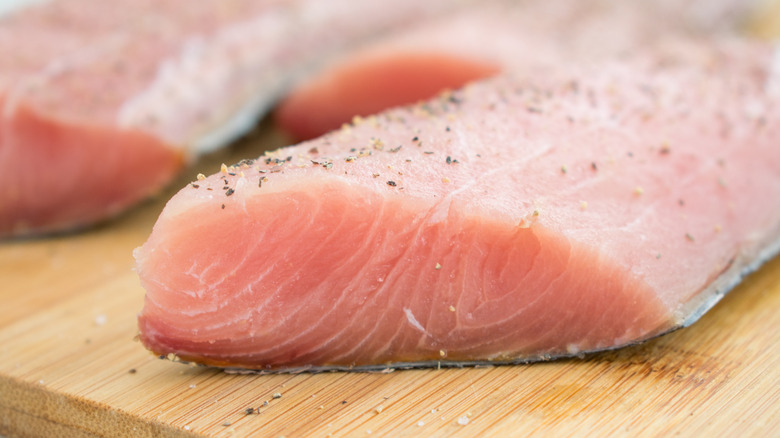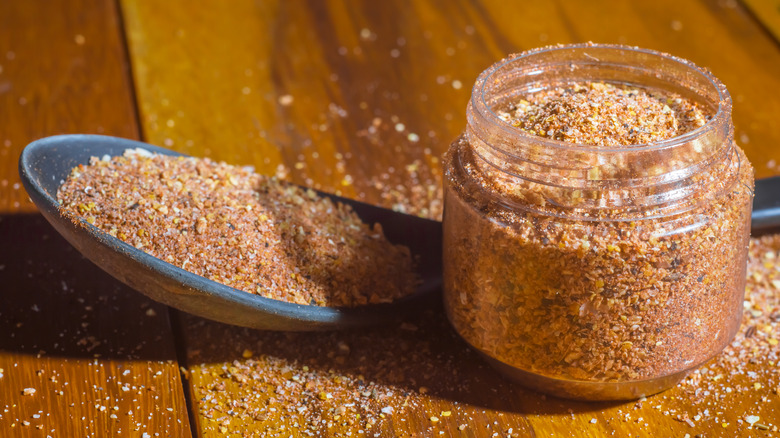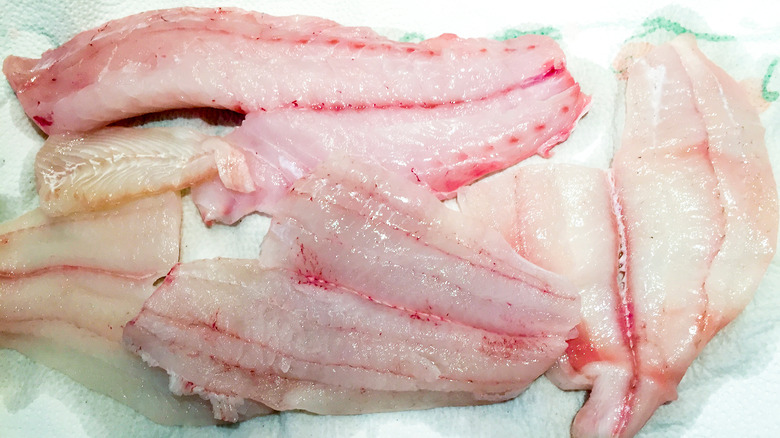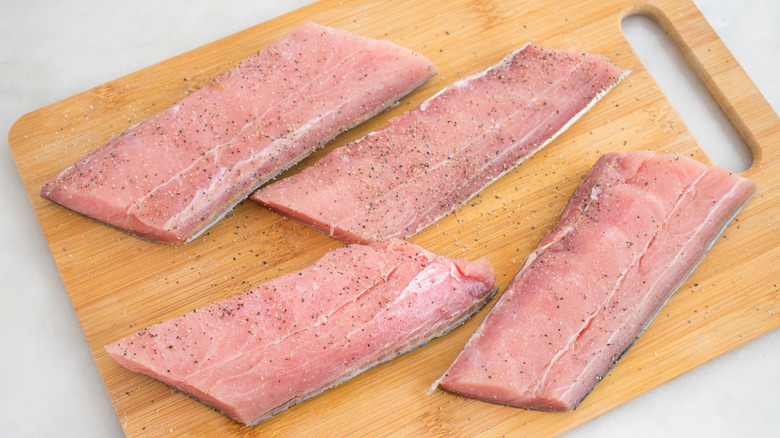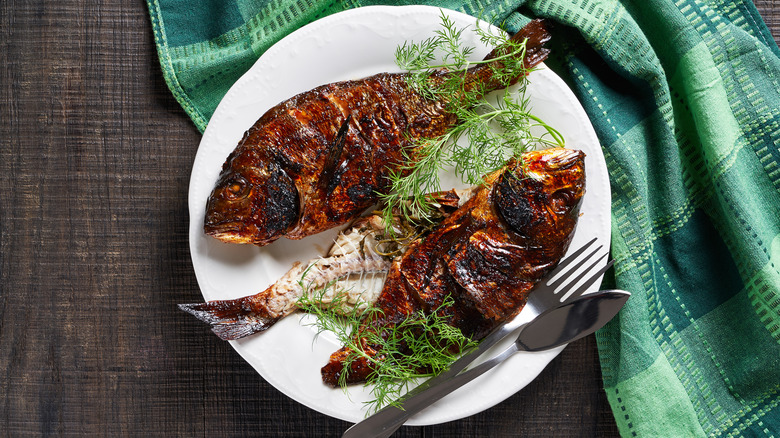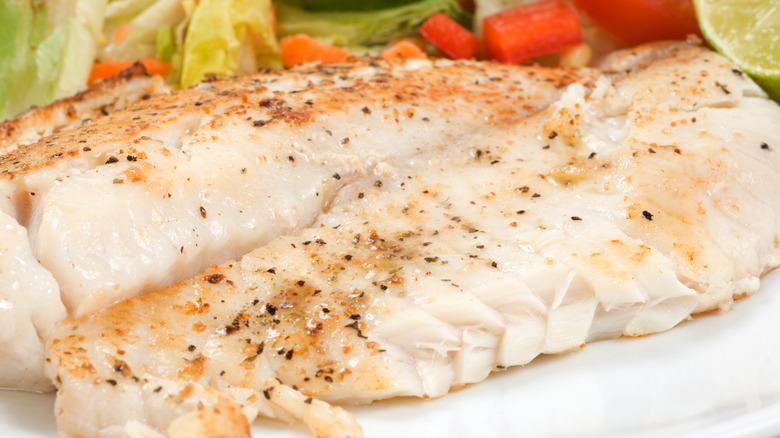9 Common Mistakes To Avoid When Cooking Mahi Mahi
Mahi mahi is a white fish known for its thick, hearty texture and mild taste. Most mahi mahi is found primarily in the Pacific Ocean surrounding Hawaii, but it's also fished in smaller quantities in the waters of the Caribbean Sea, the Gulf of Mexico, and the Atlantic Ocean. Also known as dorado or dolphinfish – don't worry, it has no relation to actual dolphins – mahi mahi earned the moniker dolphinfish because of its tendency to swim in front of ships, like dolphins.
As a personal chef, mahi mahi was a staple on my clients' menus for years because it's simple to prepare and versatile. It has a mild, slightly sweet flavor that can handle ingredients with big flavors. Its thick texture makes it perfect for a variety of cooking methods. You can pan-sear mahi mahi, bake it to perfection, grill it or fry it.
Like most fish, mahi mahi is relatively easy to cook, but it's equally easy to ruin if you aren't careful. If you can avoid these common mistakes people make when cooking mahi mahi, you'll be set up for success.
Choosing low quality mahi mahi
The first step in ensuring your mahi mahi cooks up perfectly is to choose the best quality fish available. You'll have better end results if you start with a high quality product. Like all fresh fish, mahi mahi's flesh should be brightly colored with no dark spots. Its texture should not be soft or squishy, but firm and moist. To test for firmness, press the flesh gently with a finger. It should give when pressed then return to its normal shape when you remove your finger.
If you're buying your mahi mahi whole, be sure to check the eyes. They're a good indicator of how fresh the fish really is. When a fish begins to age, the eyes become dull, dark and sunken or flat. Only choose whole fish with eyes that are shiny and full. Smell is another factor to pay close attention to when purchasing mahi mahi. When it's fresh, mahi mahi should not have a strong fish odor. The smell should be mild and not unpleasant.
Over marinating
Marinades are a great way to add flavor to foods, especially those with milder flavors, like mahi mahi. I use them consistently in my own kitchen and they were an integral part of my culinary repertoire when I cooked for my clients. Something as simple as a plain chicken breast can be transformed into a phenomenal meal after even a short soak in a flavorful marinade. Cooks are encouraged to marinate proteins like beef and poultry for hours, sometimes even days for maximum flavor, but the rules are different with mahi mahi.
The biggest mistake people make when marinating fish is to over marinate. Yes, it's possible to marinate fish for too long and the results are less than ideal. There are two key factors that make fish susceptible to over marination. First, most fish is not as hardy as meat or poultry. If its tender flesh is subjected to liquid, marinades included, for too long, the fish will lose its firmness and will be soft and squishy after it's cooked.
Most marinades include some types of acid, whether it's fresh citrus juice or vinegar. If fish is left in the marinade too long, the acid can actually start to cook the fish. Avoid marinating mahi mahi for more than one hour.
Skipping a dry rub
If you're not marinating your mahi mahi, a dry rub is also an excellent way to infuse more flavor into your fish. The difference between a marinade and a dry rub is liquid. Marinades are liquid-based and dry rubs are made with tasty blends of ground herbs and spices. They allow you to get all the flavor benefits without worries about ending up with soggy fish.
Dry rubs add to the texture of your fish, especially if you pan-sear the mahi mahi. Searing fish with a dry rub will create a wonderful crust on the surface, giving you a delicious contrast of textures with the soft, flaky fish. The crust also helps keep the fish's natural juices inside.
You can use your favorite dry rub recipe on mahi mahi or create your own with your favorite herbs and spices. Sprinkle the rub all over the surface of your mahi mahi then gently rub it into the flesh so it stays in place. Plan on using one to one and a half tablespoons of dry rub for every pound of mahi mahi. Keep in mind if your dry rub contains salt, you'll need to adjust the amount of additional salt you use to season the fish.
Cooking the fish without patting it dry
Despite the fact that mahi mahi live in water, excess water can be a problem when it's time to cook it. Just like moisture from a marinade can negatively affect the texture of your mahi mahi, so can the water that is naturally on the surface of the fish's flesh. Before seasoning or cooking your fish, be sure to pat it dry first.
Starting with a dry piece of fish is essential, especially if you're pan-searing your mahi mahi. When fish is seared, the goal is to create a crispy, golden brown crust. To achieve this, you'll need a hot pan lined with oil and a dry piece of fish. You can remove surface moisture from your mahi mahi by simply patting the filets gently with a dry paper towel. For additional insurance, you can allow the mahi mahi to rest, uncovered, for up to 30 minutes before cooking to give it additional time to dry out.
Skipping this step will cause your fish to be soft, not crisp on the outside with a tender, flaky center. When that excess moisture hits the pan it will cause your fish to steam instead of sear and you'll only be able to achieve that crispy, golden brown crust by prolonging your cooking time. This could potentially cause you to overcook your mahi mahi.
Adding salt too soon
Salt is universally revered for its ability to enhance the natural flavors of food. In culinary school, learning to season food properly with salt and pepper is a skill taught from day one. The goal is food that is flavorful, but not salty. For steaks, it's common practice to season them with salt before cooking them. Some even recommend salting your steaks as much as 40 minutes before cooking.
This is not the path to success when cooking mahi mahi. You definitely need to season mahi mahi but the timing of when you add salt can make a huge difference in how your fish turns out. Adding salt to the fish too soon is a common mistake when cooking mahi mahi and other fish.
In addition to adding flavor, salt also causes food to release moisture. It's troublesome for searing when this moisture remains on the surface of the fish as it's cooked; it's also problematic for the mahi mahi to lose so much moisture inside.The longer the salt sits on the surface of the fish, the more moisture it will pull out. The result is mahi mahi that is dry and dense instead of light and flaky. For best results, salt your mahi mahi just before cooking or as an extra precaution you can add the salt when the fish is almost cooked through.
Not getting the cooking temperature right
Pan-searing and grilling are two common methods of cooking mahi mahi, but no matter which method you choose, getting the cooking temperature right is critical. It's surprisingly simple to turn a perfect piece of fish into an unappetizing dish if your pan or grill is not hot enough.
Most fish are delicate, which can make it tricky to cook them properly. Mahi mahi's firmer flesh makes it less likely to fall apart in the pan or slip through the grates of your grill, so long as the pan or grill are at the appropriate temperature and the appropriate temperature is hot. Before adding your mahi mahi to your pan, it's important to give your pan and the oil time to heat up. Aim for medium high to high heat. The oil should just start to shimmer but not smoke. The fish should sizzle when added to the pan.
For the grill, it helps to have two different temperature zones — one hot, up to 500 F, and one cooler, around 375 F. Start the mahi mahi in the hot zone, for a good sear then transfer it to the cooler zone to finish cooking without fear of burning it. If your grill doesn't have the benefit of zones, aim for medium high heat for best results. Both a hot pan and grill will brown the fish properly and prevent the mahi mahi from sticking.
Cooking it skin side up
Fish skin can be controversial. While many fish-lovers sing the praises of properly cooked fish skin, it has just as many detractors who would rather remove it than eat it. The key to making it an enjoyable bite is to make sure the skin is cooked until it's wonderfully crispy. Taste aside, there are also nutritional benefits to enjoying fish skin. It's high in omega-3 fatty acids, vitamin E and protein.
When you're cooking mahi mahi it's important to remember to cook it skin side down so the skin is in direct contact with either a hot pan or a hot grill. The goal is skin that is crunchy and not burnt. If not cooked until crisp, the skin's texture will be tough and difficult to chew. Once the skin crisps, it's safe to flip the fish to cook the other side. You can also achieve crispy skin by broiling the mahi mahi.The crisp skin also serves as a barrier, helping the mahi mahi retain its moisture during cooking.
Not letting it cook
One of my pet peeves as a cooking instructor is watching students add food to a pan then immediately begin to stir, nudge or flip it over and over without interruption. The instinct to appear busy and actively cooking more often than not leads to food that is not properly cooked. My advice to those students is to let the food cook, especially when that food is mahi mahi.
Even though mahi mahi is a sturdy fish, it is much more likely to fall apart or stick to your pan with constant movement. If it's not allowed to rest in the pan, untouched, your mahi mahi won't brown properly or cook evenly. Once it's added to the pan, let the fish cook, without bothering it, for three to four minutes to give it time to sear and brown before flipping it. Less is more when it comes to moving or flipping fish as it cooks.
Every time you move or flip the mahi mahi, you're suspending the cooking process. It will take longer to cook your fish and you'll risk drying it out or eventually burning it.
Overcooking
Overcooking is the easiest way to ruin a good piece of fish and it's one of the most common mistakes people make when cooking it. It's often the result of a cook's desire to not eat or serve undercooked fish, which can be dangerous to consume. The problem with overcooked mahi mahi is that instead of tender and flaky it becomes parched and tough. The goal is to cook mahi mahi just until it's cooked through and no longer.
If you have a meat thermometer, pull it out when you're cooking mahi mahi to ensure the fish reaches an internal temperature of 145 F. If you don't have a thermometer, you can estimate cooking time for your mahi mahi in a couple of ways.
You can sear it in a hot pan for three to five minutes on each side. This is a general guide for an average size piece of fish. You can also estimate about 10 minutes of cooking time for each inch of the fish's thickness. Remember to flip the fish halfway through. Once the fish is done, remove it from the pan or grill and serve it immediately.

